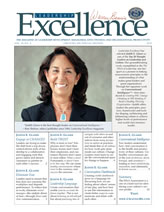By Judith E. Glaser and Jeremy Nash | Leadership Excellence
Published July 2005
Make new leadership connections.
We've grown up in a century of I-centrism where the image of leader as hero has prevailed. This image inspired, for many of us, our own notions of leadership, but it is a misguided image for these times.
Great leaders establish a we-centric presence, one that values and harnesses the collective intelligence and imagination, analytic know-how, and business acumen of their enterprise.
What is your leadership presence? Are you an I-centric or we-centric leader? What are ways you can lead from a we-centered place, influencing the future in a more positive, productive, and fulfilling direction?
Story: Bill was a senior executive in a technology company. Bill forgot the most important dynamic of a We-centric leader—to engage and attune to his constituents: his customers, partners, and shareholders. That connection requires being interested in and listening for what’s important to others in order to deliver on the mission.
By not being attuned to those people connected to him in realizing the company vision, the leader risks disenfranchising others. Those looking to the leader for direction may slip into resistance and skepticism.
Let’s look at Bill through five different lenses:
- How he talks: His voice is often loud. He’s insistent on his point of view. He may drown out others, speaking over them. He makes authoritative statements but doesn’t balance those with interested questions where he’s looking to learn something— questions for which he has no answers. His words are often harsh and critical, as is his tone and mannerisms. His presence, especially when he’s impatient, intimidates other people.
- How he motivates others: He believes that tough competition brings out the best in people’s performance. He got to the top that way, but he doesn’t recognize that the dark side of competition may mean I-centric behavior down through the ranks, as people stifle the sharing of information, hog credit, and place their looking good individually over the good of the team.
- How he listens: He critiques other’s ideas and opinions, looking to agree, rebut, or dismiss them. In his haste to make a decision, he doesn’t allow much space for others to formulate their views and contribute to the discussion.
- What he does to assert himself: He believes that his job is to have answers, to give strong direction, and to be an authority, and so he asserts himself through power. He is the boss, authority, and holder of the vision. He believes that he is to lead and others are to follow.
- How he uses his positional power: Bill believes that positional power gives him final veto over everything. He rarely asks for opinions, opting to state his instead. When he asks for opinions, he appears to be interested, however he overrides others when he feels his position is not being supported.
Without realizing it, Bill is living inside an I-centric view of leadership. The impact is that people often feel left out, resentful, and resigned. They feel disconnected from the vision, values, purpose, and mission.
Many of us have the notion that a strong, capable leader must have a charismatic presence. Yet the top performing companies are seldom led by charismatic leaders, rather they are led by leaders who know how to build great teams and help them stay focused on collaboratively achieving audacious goals.
We-centric leadership presence refers to how people feel in the leader’s presence. We-centric leaders are those who:
-
 Inspire others to want to engage.
Inspire others to want to engage. - Create a pull energy more than a push energy by asking more questions to draw out others rather than pushing your ideas on others. Get people excited about what “we can do together.”
- Give information and share what they know because they know they will get back more than they give.
- Send pure communication. They invest in open communication that invites discussion. They do not hide behind pretense or send double messages.
- Align their tone of voice, body language, words, and attitude to communicate trust and sincerity. What are steps you can take to become a We-centric Leader?
- Recognize that you don’t need to know all the answers yourself.
- Have humility. See that admitting to mistakes is the mark of a wise leader.
- Set high performance standards: use mistakes as opportunities for learning, not punishment.
- Hear what others have to say and listen for what you can learn from them.
- Realize that resistance to your ideas is an opportunity for research rather than for intimidation or confrontation.
- Be committed to leaving every conversation a smarter person.
- Constantly look to grow the capacity of your team and organization.
- Recognize the worth of shared values and principles, and model them; to do otherwise is to betray yourself.
- By shaping your leadership presence, you are more prepared to catch and correct yourself when you stray from your new core. Continually operating from we-centric values will inspire others to want to work with you.




